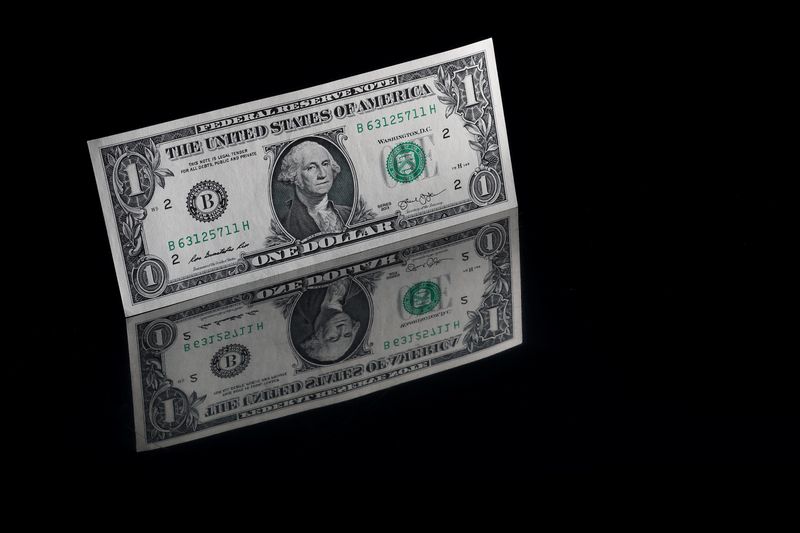Forex
Analysis – Tumbling U.S. dollar a boon to risk assets across the globe


© Reuters. A U.S. one dollar banknote is seen in this illustration taken November 23, 2021. REUTERS/Murad Sezer/Illustration
By Saqib Iqbal Ahmed
NEW YORK (Reuters) – Cooling U.S. inflation is accelerating a decline in the , and risk assets around the world stand to benefit.
The dollar is down nearly 13% against a basket of currencies from last year’s two-decade high and stands at its lowest level in 15 months. Its decline quickened after the U.S. reported softer-than-expected inflation data on Wednesday, supporting views that the Federal Reserve is nearing the end of its interest rate-hiking cycle.
Because the dollar is a linchpin of the global financial system, a wide range of assets stand to benefit if it continues falling.
Weakness in the dollar can be a boon to some U.S. companies, as a weaker currency makes exports more competitive abroad and makes it cheaper for multinationals to convert foreign profits back into dollars.
The U.S. technology sector, which includes some of the big growth companies that have led markets higher this year, generates just over 50% of its revenues overseas, an analysis of Russell 1000 companies by Bespoke Investment Group showed.
Raw materials, which are priced in dollars, become more affordable to foreign buyers when the dollar declines. The S&P/Goldman Sachs Commodity Index is up 4.6% this month, on pace for its best month since October.
Emerging markets benefit as well, because a falling U.S. currency makes debt denominated in dollars easier to service. The MSCI International Emerging Market Currency Index is up 2.4% this year.
“For markets, the weaker dollar and its underlying driver, weaker inflation, is a balm for everything, especially for assets outside the U.S.,” said Alvise Marino, foreign exchange strategist at Credit Suisse.
The greenback’s tumble has come as U.S. Treasury yields eased in recent days, dulling the dollar’s allure while boosting a wide range of other currencies, from the Japanese yen to the Mexican peso.
“That sound you hear is the breaking of technical levels across the foreign exchange markets,” said Karl Schamotta, chief market strategist at Corpay. “The dollar is plunging toward levels that prevailed before the Fed started hiking, and we’re seeing risk-sensitive currencies melt up on a global basis.”
A continued fall in the dollar could boost profits for foreign exchange strategies such as the dollar-funded carry trade, which involves the sale of dollars to buy a higher-yielding currency, allowing the investor to pocket the difference.
The dollar’s decline has already made the strategy a profitable one this year: An investor selling dollars and buying the Colombian peso would have collected 25% year-to-date, while the Polish zloty has yielded 13%, data from Corpay showed.
Paresh Upadhyaya, director of fixed income and currency strategy at Amundi US, is bearish on the dollar while betting on gains in the Kazakhstan tenge, Uruguayan peso and Indian rupee.
“When you look at what’s going on right now, the outlook for the dollar remains pretty bleak,” said Upadhyaya, who expects carry trades to thrive if the dollar keeps falling.
In the world of monetary policy, the dollar’s decline may be a relief to some countries, as it removes the urgency for them to support their falling currencies.
Among them is Japan. The greenback has tumbled 3% against the yen this week and is set for its biggest weekly fall against the Japanese currency since January. Yen weakness has been problematic for Japan’s import-reliant economy and raised expectations Japan would again intervene in markets to support its currency after doing so for the first time since 1998 last year.
Traders have also been watchful for potential action from Sweden’s central bank given weakness in the Swedish krona. But this week, the dollar is down almost 6% against the krona and set for its biggest weekly drop since November.
Continued strength in the yen could see investors unwind the large bearish positions that have built up against the currency in recent months, pushing it higher, said Societe Generale (OTC:) currency strategist Kenneth Broux.
Of course, being bearish the dollar has its own risks. One is a potential rebound in U.S. inflation, which could stoke bets on more Fed hawkishness and unwind many of the anti-dollar trades that have prospered this year.
Though inflation has cooled, the U.S. economy has remained resilient compared with other countries and few believe the Fed will cut rates anytime soon, which could potentially limit the dollar’s near-term downside.
Still, Helen Given, FX trader at Monex USA, believes the Fed will wrap up its rate-hiking cycle before most other central banks, sapping the dollar’s long-term momentum.
While the dollar may pare some of its recent losses, “looking six months out it’s likely the dollar will be even weaker than it is today,” she said.

 Forex3 years ago
Forex3 years agoForex Today: the dollar is gaining strength amid gloomy sentiment at the start of the Fed’s week

 Forex3 years ago
Forex3 years agoUnbiased review of Pocket Option broker

 Forex3 years ago
Forex3 years agoDollar to pound sterling exchange rate today: Pound plummeted to its lowest since 1985

 Forex3 years ago
Forex3 years agoHow is the Australian dollar doing today?

 Cryptocurrency3 years ago
Cryptocurrency3 years agoWhat happened in the crypto market – current events today

 World3 years ago
World3 years agoWhy are modern video games an art form?

 Commodities3 years ago
Commodities3 years agoCopper continues to fall in price on expectations of lower demand in China

 Economy3 years ago
Economy3 years agoCrude oil tankers double in price due to EU anti-Russian sanctions





















